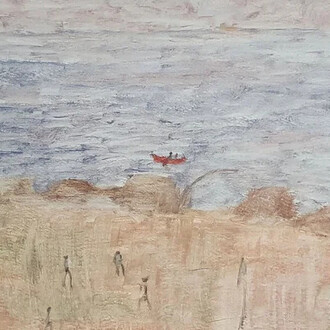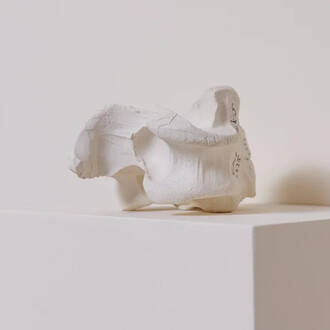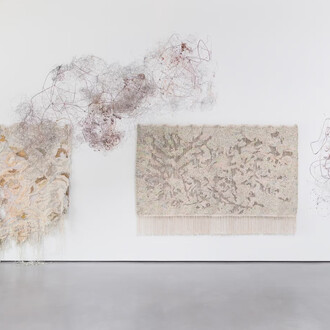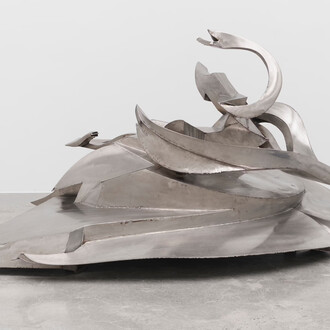Exhibiting for the first time at Piero Atchugarry Gallery, French artist, Pauline d’Andigné presents, Melting point, an inaugural solo-exhibition unveiling works of a hybrid nature, both pictorial and sculptural, conveying themes of rebellion, vulnerability, impermanence, and loss of innocence. d’Andigné brings together a series of never-before exhibited paintings, and a site-relational installation that features melting flower sculptures suspended from harsh metal chains, in an aggressively industrial, anti-precious manner.
By taking a traditionally delicate motif, d’Andigné exposes a twisted and audacious subversion from innocence. Her paintings double down on this confrontational ethos through the frenzied application of vivid colors, and unrestrained gestures with the use of oil pastels, suggesting a childlike, uninhibited freedom. Melting point emanates a bold, anarchic energy that lends itself to the rebellious punk spirit and liberating essence that permeates this body of work.
Fueled by abstraction, Pauline d’Andigné’s paintings embrace a state of ambiguity that allows for alternative ways of processing what is seen. The first stage of the artist’s process consists of washing the fabric with bleach in random areas, followed by screen printing and oil pastels, which in some places leaves a raw, gradient pattern. Such is observed in Big flowers on yellow grid (2023), where the juxtaposition of the raw bleached moments and frenetic doodles evoke the carefree stream-of-consciousness of early childhood. As the title suggests, enlarged flower motifs blend into spectrums of soft and fluid forms, revealing an organic symbiosis throughout the canvas, or as the artist states, “the fleeting and chaotic entanglement of youthful memories’’.
In Large doodle on yellow strip (2023), an intrusive yellow rectangle sits at the top of the canvas, as it descends into a more primal flurry taking place at the bottom of the canvas. d’Andigné’s composition defies the “stay in the lines” artistic dogma taught at an early age, instead eliciting a liberation of form. Yet, amidst visual chaos lies undeniable skill and intention— d’Andigne continues: “Learning different techniques involves a form of exploration in the studio; it leaves room for doubt, for error, and pushes me to establish my own rules. Paradoxically, it is in these spaces of uncertainty, relying on these rules to which I submit entirely, that I feel I have the freedom to create gestures that belong entirely to me”.
Ominously hung among the paintings is Dark bues flowers (2024), a forest-like installation of melting black vinyl flowers strung on chains throughout the exhibition space, creating a playful yet menacing encounter. The installation reflects on the artist’s early diagnosis of diabetes at the age of four, fostering a profound awareness of her body’s dysfunctions from childhood. Between the uncanny and the grotesque, these flowers must be re-examined as viewers confront them in a drooping state, suggesting a purity decaying over time under the ordinarily unseen processes of biological degeneration.
Viscerally captivating, Pauline d’Andigné’s Melting point is an ode to the true embodiment of the rebellious punk spirit. Collectively, these works reveal a powerful dialogue that merges ambiguity and repetition with an idiosyncratic painting style all her own.
Pauline d’Andigné (b. 1996, France) is a 2021 graduate from the École des Beaux-arts de Paris, Pauline d’Andigné lives and works in Paris. Her work in sculpture, installation, painting and photography gives close attention to materials, textures and their articulation in space, reflecting the consumer and visual bulimia characteristic of the hypermodern world in which we live. The resulting forms are familiar and recognizable, often tending to excess. Perishable elements, frozen fluids, bleached fabric, the inconstancy of soft sculptures, all contribute to giving the work a vibration that suggests an intuition of imminent self-destruction.
















